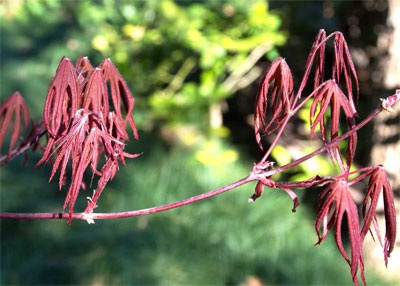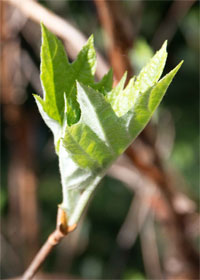Evaluating Cold Injury

Japanese maple’s new growth looks like it froze, but it didn’t.

Oakleaf hydrangea’s leaves show no ill effects from the cold.
Isn’t it funny, how some plants are given the genes to withstand sub-freezing weather and still remain in flower, while other plants crater the moment it drops below 32.0 F. Actually, there are some plants like bougainvilleas, caladiums and aglaonemas that suffer chill injuries at temperatures considerably warmer than freezing. So, go figure.
This week big parts of Texas dropped below freezing for one or two nights. Here are some stream-of-consciousness thoughts about what might have been lost and what might come back….
Vegetables: Tender transplants of tomatoes and peppers and seedlings of beans, squash and others are probably lost if they were hit by sub-freezing weather. You can still replant any or all of those. You have time to get a crop into the garden and onto the table. Potatoes, however, cannot be replanted this late. They’ll probably resprout from the original plantings, so just leave them alone. While harvest may be delayed and reduced, they’ll still be productive. It’s too late to replant both onions and potatoes. Hot weather will come up too soon.
Flowers: Hopefully you didn’t have tender new summer annuals planted yet. If you did, and if they’re crisp, you’ll have to go to Plan B. Meanwhile, look at how well snapdragons, pinks, pansies, petunias, chard, kale and other winter color plants stood up to the cold. You might want to remember to plant them next winter and early spring. You can start replanting with summer annuals, depending on where you are, either right away (South and South Central Texas), or in one to three weeks in the rest of the state.
Lawns: Now you see why we don’t recommend feeding turf too early — the nutrients are largely wasted. In South Texas, feed now. Wait a couple of weeks in North Texas. You can sod new grass now, but wait until it’s fairly warm before sowing bermuda seed. If you see zig-zag patterns in your bermudagrass, that’s just frost damage. It will quickly outgrow it.
Woody plants: Most shrubs and trees have come through the freeze, frost and chill without damage. If flowers were lost, they won’t be replaced. But, in the off chance that you lost leaves on some species, those plants will almost assuredly resprout with new growth in the next couple of weeks. If in doubt, just sit tight. Let the twigs be your guides. If they’re shriveled and crisp, you can trim them away. Most, however, will still be firm — only the leaves will be browned. Don’t rush to prune them.
Fruit, specifically peaches and plums: These plants had just finished blooming in South Texas. They were in full bloom in North Central Texas, and they were in bud in more northern areas. For those plants that were hit by sub-freezing weather with either small fruit or open flowers, only time will tell. You’ll know within 2 to 3 weeks (or less) if you’ll get any crop. Those in bud should still be OK. Just sit tight to see.
A Related Note:
Easter’s date varies by almost four weeks over the years, so comments like “I always wait to plant until after Easter” can catch you planting too early or too late, depending on where you are and when Easter rolls around for that given year. The better measure is the average date of the last killing freeze for your county. Let that be your guide, because on that date, you still have a 50-50 chance of encountering at least one more killing freeze.
